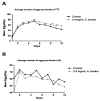Angelica keiskei Impacts the Lifespan and Healthspan of Drosophila melanogaster in a Sex and Strain-Dependent Manner
- PMID: 37242522
- PMCID: PMC10222730
- DOI: 10.3390/ph16050738
Angelica keiskei Impacts the Lifespan and Healthspan of Drosophila melanogaster in a Sex and Strain-Dependent Manner
Abstract
Angelica keiskei is a perennial plant, belonging to the Apiaceae family and originating from Japan. This plant has been reported to act as a diuretic, analeptic, antidiabetic, hypertensive, tumor, galactagogue, and laxative. The mechanism of action of A. keiskei is not known, but previous studies have suggested that it may act as an antioxidant. In this work, we used Drosophila melanogaster to evaluate the impact of A. keiskei on lifespan and healthspan and its potential anti-aging mechanism by conducting multiple assays on three fly strains: w1118, chico, and JIV. We observed that the extract extended lifespan and improved healthspan in a sex- and strain-dependent manner. A. keiskei extended lifespan and improved reproductive fitness in female flies and either had no effect or decreased survival and physical performance in males. The extract protected against the superoxide generator paraquat in both sexes. These sex-specific effects suggest that A. keiskei may act through age-specific pathways such as the insulin and insulin-like growth factor signaling (IIS) pathways. Upon examination, we found that the increased survival of A. keiskei-fed females was dependent on the presence of the insulin receptor substrate chico, supporting the role of IIS in the action of A. keiskei.
Keywords: Angelica keiskei; Apiaceae; Drosophila melanogaster; healthspan; insulin/IGF-1 pathway; lifespan.
Conflict of interest statement
The authors declare no conflict of interest.
Figures





Similar articles
-
Angelica keiskei water extract Mitigates Age-Associated Physiological Decline in Mice.Redox Rep. 2024 Dec;29(1):2305036. doi: 10.1080/13510002.2024.2305036. Epub 2024 Feb 23. Redox Rep. 2024. PMID: 38390941 Free PMC article.
-
Extension of Drosophila lifespan by cinnamon through a sex-specific dependence on the insulin receptor substrate chico.Exp Gerontol. 2014 Dec;60:220-30. doi: 10.1016/j.exger.2014.09.019. Epub 2014 Oct 16. Exp Gerontol. 2014. PMID: 25456850 Free PMC article.
-
Drosophila Longevity Assurance Conferred by Reduced Insulin Receptor Substrate Chico Partially Requires d4eBP.PLoS One. 2015 Aug 7;10(8):e0134415. doi: 10.1371/journal.pone.0134415. eCollection 2015. PLoS One. 2015. PMID: 26252766 Free PMC article.
-
Angelica keiskei, an emerging medicinal herb with various bioactive constituents and biological activities.Arch Pharm Res. 2017 Jun;40(6):655-675. doi: 10.1007/s12272-017-0892-3. Epub 2017 Apr 24. Arch Pharm Res. 2017. PMID: 28439780 Free PMC article. Review.
-
Possible antithrombotic effects of Angelica keiskei (Ashitaba).Pharmazie. 2018 Jun 1;73(6):315-317. doi: 10.1691/ph.2018.8370. Pharmazie. 2018. PMID: 29880082 Review.
Cited by
-
Effects of Silibinin on Delaying Aging in Drosophila melanogaster.Antioxidants (Basel). 2025 Jan 27;14(2):147. doi: 10.3390/antiox14020147. Antioxidants (Basel). 2025. PMID: 40002334 Free PMC article.
-
Angelica keiskei water extract Mitigates Age-Associated Physiological Decline in Mice.Redox Rep. 2024 Dec;29(1):2305036. doi: 10.1080/13510002.2024.2305036. Epub 2024 Feb 23. Redox Rep. 2024. PMID: 38390941 Free PMC article.
References
-
- Amalia R., Aulifa D.L., Zain D.N., Pebiansyah A., Levita J. The Cytotoxicity and Nephroprotective Activity of the Ethanol Extracts of Angelica keiskei Koidzumi Stems and Leaves against the NAPQI-Induced Human Embryonic Kidney (HEK293) Cell Line. Evid.-Based Complement. Altern. Med. 2021;2021:1–6. doi: 10.1155/2021/6458265. - DOI - PMC - PubMed
Grants and funding
LinkOut - more resources
Full Text Sources
Molecular Biology Databases

